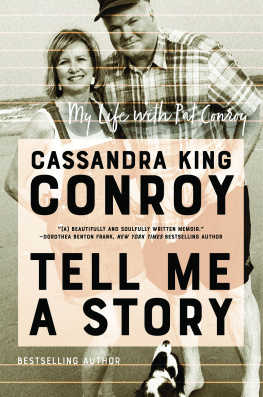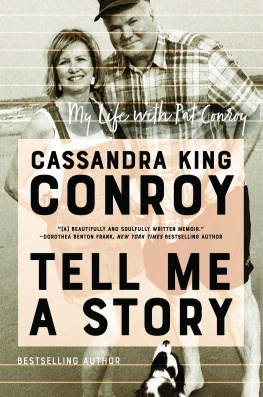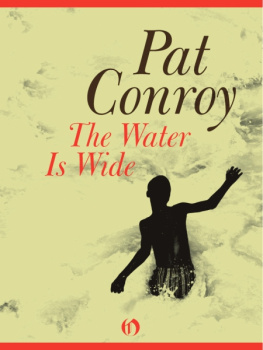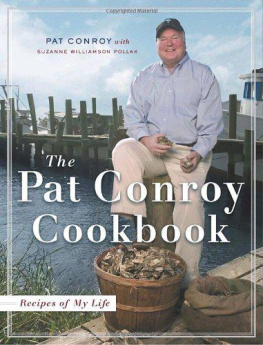My Exaggerated Life
My Exaggerated Life

Pat Conroy
As Told to
Katherine Clark

THE UNIVERSITY OF SOUTH CAROLINA PRESS
Publication is made possible in part by the generous support of the University Libraries, University of South Carolina.
2018 Katherine Clark
Published by the University of South Carolina Press
Columbia, South Carolina 29208
www.sc.edu/uscpress
27 26 25 24 23 22 21 20 19 18
10 9 8 7 6 5 4 3 2 1
Library of Congress Cataloging-in-Publication Data can be found at http://catalog.loc.gov/
ISBN 978-1-61117-907-1 (cloth)
ISBN 978-1-61117-908-8 (ebook)
Front cover photograph Jim Herrington
This book is dedicated
to the memory of
PAT CONROY,
whose friendship changed my life.
Contents
Introduction
A story untold could be the one that kills you.
PAT CONROY, Beach Music
Pat Conroy is a famous, best-selling, beloved American author who has won a place in the hearts of millions of readers with his books The Great Santini, The Lords of Discipline, and The Prince of Tides, among many others. Pat Conroy was also an American original: a military brat, an adopted son of the Carolina lowcountry, a starting point guard for a Division I college basketball team, a self-made writer, a champion of the underdog, and a friend of little people. Many know and love this mans work, but most will not have had an opportunity to get to know the inimitable man himself. The purpose of this book is to capture Pat Conroy in full measure, so that readers who never met this singular American character will have their chance to encounter him in these pages and experience something of what it was like to hear his stories in person, as only he could tell them.
Conroys readers will already know a great deal about the authors life from his autobiographical fiction and nonfiction. We will learn a good deal more from the inevitable scholarly biographies that will follow in due time. This book does not attempt to supplant or compete with an academic rendering of Conroys life and in fact strives to avoid too much overlap with well-known Conroy lore and previously published material. When a major subject of Conroys lifelike his mothers death, for examplereceives scant attention in these pages, thats either because Conroy has written extensively on this subject in other works, or because he was not interested in addressing it here. What this book seeks is not to offer a comprehensive accounting of the authors life, but to preserve the voice, the character, the personality, and the humanity of Pat Conroy in the amber of his own spoken words.
To that end, no one actually wrote this book. I interviewed Pat Conroy for about two hundred hours and edited the transcripts of our recordings into a narrative that hews as closely as possible to the tone and spirit of Conroys words. My job was to select and structure the text on the page, but whats on the page is Conroy speaking. Here Conroy is the narrator of his life, not the scholar of it. It was not my job to be the scholar of his life here either; that enterprise is for a different book. My role was simply to be an editor who enabled Conroy to be Conroy. And when Conroy is being Conroy, I find him an extremely reliable and credible narrator, but the fact remains that the narrative here is his life as he remembers it and chooses to tell it. On the one hand, I am certain that Pat made a disciplined effort to be as accurate and honest with me as he could be. On the other hand, I am equally certain that some of the stories he told me reflect how a writers imagination takes hold of real events and makes them better in the telling over years of retelling.
In editing our transcripts, my philosophy was to let Pat be Pat on the page as he was in our interviews, because this kind of book should provide a warts-and-all portrait of a character, along with the gaffes and all narrative of his life, as straight from the horses mouth as feasible. My responsibility is to share what he told me, because this represents what readers would have heard for themselves if they had met Pat at Griffin Market or sat with him on his balcony as he told stories. And this is the purpose of the book. Instead of hewing literally to any factual record, an oral biography is designed to convey many other kinds of truths about character and voice. Whats in these pages offers a glimpse into Pat Conroys psyche and the emotional reality he lived with from day to day, year to year.
Here is Pats philosophy on the subject of his own nonfiction, including the interviews we recorded for this book: In memoir, you better make sure youre dealing with the truth as best you can tell it, as best you can carve it out, as best you can remember it. The problem is, once its in a book, its going to sound like the whole truth, and its not going to be. Its the truth as best I can put it together. But its not going to be the whole truth, because everybodys version of what happened is a little different; and its not going to be the literal truth because I dont have a recording of my life. He also noted: My answers can change on a daily basis. I can say something portentous as though Im giving the final benediction on something, and then I will say something completely different the very next day.

Memoirist and novelist, Pat Conroy was also a raconteur who delighted audiences as well as friends and family with his storytelling. Not every writer is a great raconteur, just as not every raconteur has the ability to be a good writer. In fact the first oral biography on which I collaborated came into being because the black midwife Onnie Lee Logan did not know how to write. On the other hand, she was a great storyteller out of the oral tradition of the African American South, in which knowledge and information are stored and passed down through stories told and repeated over generations. The Capote-esque bon vivant Eugene Walter of the second oral biography I worked on was a good writer who produced a few novels and poems, but these did not come close to his brilliance as a raconteur whose stories captured the brilliance of a uniquely well-lived life.
Likewise, great writers are often not great talkers. William Faulkner, for example, was notorious for being taciturn in public and speaking only in monosyllables. He preferred to listen and observe, especially when others were doing the storytelling on the front porch of the general store or at the hunting lodge where he was a regular guest. He internalized the stories told by the raconteurs in his family and community and later spun them into literary gold, but he himself was much more writer than raconteur.
Pat Conroy was one of those rare beings whose gift with the spontaneous spoken word equaled his skill at crafting the written word. However it is not Conroys celebrity as an author that makes him a great subject for an oral biography. In fact I prefer unknowns as subjects and was initially leery of any project involving a famous person. The first two subjects of the earlier oral biographies I worked on had both done great things with their lives against huge odds, but not to the point that the world knew who they were or what theyd done. This anonymity did not bother either of them or detract from their own sense of personal success. Both individuals had a strong sense of identity that empowered them to pursue lives of great meaning and fulfillment. One lesson of these lives is that the inner conviction of being somebody is more important than the celebrity bestowed by public opinion or acclaim. Then, through the act of narrating their life stories, both these nobodies showed the world what it means to be somebody.
Next page









